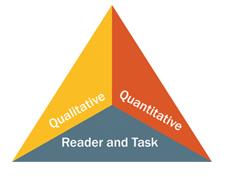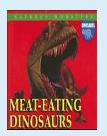May 22, 2014
When my son Justin was young he was a dinosaur omnivore. He voraciously ate everything related to dinosaurs. He checked out dinosaur videos at the library; he read about allosaurus; he drew protoceratops; he told grandma about velociraptors; and he wore his triceratops t-shirt almost every day. No dinosaur was safe from his appetite.
I learned about text complexity as a mom before I learned about it as an education professional. If a dinosaur name had 6 syllables, I watched my son decode each one carefully and then put them together to form a word that allowed him to have a name for that particular and spectacular reptile he saw on the page. I recognized well before he entered school that the ability to read and understand complex text successfully is a multi-faceted reality.
The Common Core State Standards model of text complexity is multi-dimensional. The 3-part model consists of quantitative dimensions, qualitative dimensions, and reader and task considerations and is often represented by this visual:
But what do these dimensions really mean? I’ll explore the dimensions through the lens of a 5-year old dinosaur omnivore.
Many of the words in the dinosaur books my son read were difficult. He often read books like Meat-Eating Dinosaurs by Brenda Ralph Lewis.
The measure of quantitative difficulty is an ATOS level of 5.3– meaning the book is written in a way that is understandable to individuals who have reading comprehension skills typical of a student near the start of fifth grade. He wasn’t reading at the fifth-grade level by any means. So why could he successfully read this book?
The other dimensions of text complexity held the key to his success. The qualitative dimension of text complexity are those aspects of text measured by a human reader—levels of meaning or purpose, language conventionality and clarity, and knowledge demands. My son had built a significant base of experience around the language of dinosaurs. The books were often literal and factual in their level of meaning. Given the background knowledge he was continuously building, he was well equipped to comprehend complicated passages and descriptions.
The third dimension of text complexity is reader and task considerations. In a school setting this dimension is the craft of great teachers who know each child and know the task at hand. What background does this child bring to the task at hand and how difficult is that task? For my son the task was always pretty straightforward–to answer his own questions (OK, and to stump his parents with dino facts). Where did this dinosaur live? How did it die? What did it eat? Who first found its bones? And for this reader his motivation was always high. No dinosaur book was beyond his willingness to try to understand.
Working together, these three dimensions intersect and interact to impact the level of complexity of a piece of text in relation to an individual reader given a particular task. A text that is extremely complex and difficult for one child may be easily understood by another child even though those two children may be reading at essentially the same level. They’re bringing different experiences to the text, and they may be doing very different tasks with that text.
An educator’s goal is to find that dinosaur in each child, to find the tasks and topics around reading that ignite that fire of curiosity within each child. Then when the fire is lit, teachers work to fan the flames and equip children to be able to read and comprehend many different types of texts of increasing difficulty.
At Renaissance we want to help. Renaissance Accelerated Reader® is designed to help teachers guide students to read widely and deeply from a broad range of books, incorporating daily reading practice into the school day, setting individualized reading practice goals, and monitoring progress toward those goals. Every Accelerated Reader title includes a measure of quantitative difficulty–an ATOS level. Starting this fall we’re pleased to announce that every Accelerated Reader title will also include a Lexile measure. Renaissance customers can choose which measure of text complexity works best for them. The Lexile measure will be available in Renaissance Star Reading® and Accelerated Reader this fall, and available in other Renaissance reading products during the 2014-2015 school year. Both leveling systems are reliable measures of a book’s text complexity as evidenced by the Student Achievement Partners study cited in the Supplemental Information for Appendix A of the Common Core State Standards for English Language Arts and Literacy: New Research on Text.
I’ll use Meat-Eating Dinosaurs as an example again. This book has an ATOS level of 5.3 and a Lexile level of 890L. Same great book; just two different scales used to express the difficulty of the text. Educators, you can decide which measure to use. We’ll always rely on you to decide the task for the book, and you’re the only one who knows the reader coming to the task.
As for my son Justin, he’s now a Dean of Instruction at a KIPP middle school in Kansas City. He’s working to light and fuel that love-of-reading fire in every one of his students because he knows that’s a critical piece of their future success. He wants a school full of (insert subject here)-reading omnivores.
Curious to learn more? Explore Renaissance Accelerated Reader 360®, the latest version of Accelerated Reader.



